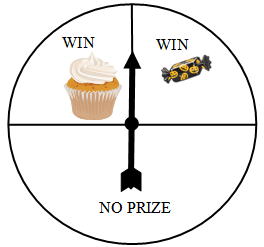Spin a surprise
0
Overview
Using this Resource
Connecting to the Curriculum
Marking Student Responses
Working with Students
Further Resources
This task is about how likely things are to happen.

Sharni spins the arrow to see if she wins a prize at her school gala.
| a) | i) |
Which of these is true? (circle one)
|
|
| (A) |
Sharni is more likely to win a sweet than a muffin.
|
||
| (B) |
Sharni is more likely to win a muffin than a sweet.
|
||
|
(C)
|
Sharni is just as likely to win a muffin as a sweet.
|
||
| ii) |
Explain your answer.
|
||
| b) | i) |
Tana has a spin. Which of these is most likely? (circle one)
|
|
| (A) | Tana wins a prize. | ||
| (B) | Tana does not win a prize. | ||
|
(C)
|
Tana is just as likely to win a prize as he is to not win one.
|
||
| ii) |
Explain your answer.
|
||
Task administration:
This task is completed with pencil and paper only.
Levels:
2, 3
Curriculum info:
Keywords:
Description of task:
Students recognise equal and different likelihoods when playing a game of chance.
Curriculum Links:
This resource can be used to provide one source of evidence to suggest students' understanding of comparing and explaining likelihoods of outcomes for simple situations involving chance.
Learning Progression Frameworks
This resource can provide evidence of learning associated with within the Mathematics Learning Progressions Frameworks.
Read more about the Learning Progressions Frameworks.Answers/responses:
| Y5 (05/2010) | |||
| a) |
i) ii)
|
D Any 1 of:
|
moderate difficult
|
| b) |
i) ii)
|
D Any 1 of:
|
moderate very difficult
|
Based on a representative sample of 153 students.
NOTE: If the student make statements about the position of the spinner, check that they understand that this is the beginning position before the arrow is spun. They may then wish to amend their answers. This resource looks at uncovering students' conceptions and misconceptions in probability reasoning. The explanation is more revealing of students' thinking than the multiple choice response.
Diagnostic and formative information:
There are many well known misconceptions about probability. Examples of these follow.
For more information click on the link Probability concept map: Common misconceptions.
The letters [A], [B] or [C] in each example below is the response the student chose in the multiple choice part of that question.
| Likely misconception | |
| a) - b) |
Outcome misconception Some students may respond to situations involving chance by stating that you just can't tell anything when it comes to probability.
|
|
a) - b)
|
Influence misconception Students believe that previous events can be influenced by a range of factors. For example, the outcome of a coin toss may depend on what the previous toss was. The way the spinner is spun
What the person wants (or needs) to happen
The original position of the spinner has an influence
|
| a) |
Lack of independence / Negative regency misconception (previous outcomes have an influence)
|
|
a) - b)
|
Assumes spinner finishes where it started (see NOTE under the scoring guide)
|
| b) |
Equiprobability misconception The student sees events as equally likely even when they have different probabilities.
|
|
a) - b)
|
Availability misconception
Features of the prize: It is bigger, nicer, worth more etc.,
|
|
a)
|
States what the prize will be (with no justification)
|
Next steps:
Each of these probability misconceptions above is common, even with adults.
There are three main ways we suggest can help students overcome their incorrect ideas.
- Have discussions between students. Get them to justify their own explanations and to critique the explanations of others. Click on the link Mathematical classroom discourse for more ideas on how to do this.
- Have plenty of practical experiences of probability, and record the results of this. Increasing exposure to and experience of probability builds up an intuitive feel for chance.
- Find ways to quantify probability. This should be with simple counts for fixed sample sizes at these year levels.
For more information about probability, go to the ARB Probability concept map.

